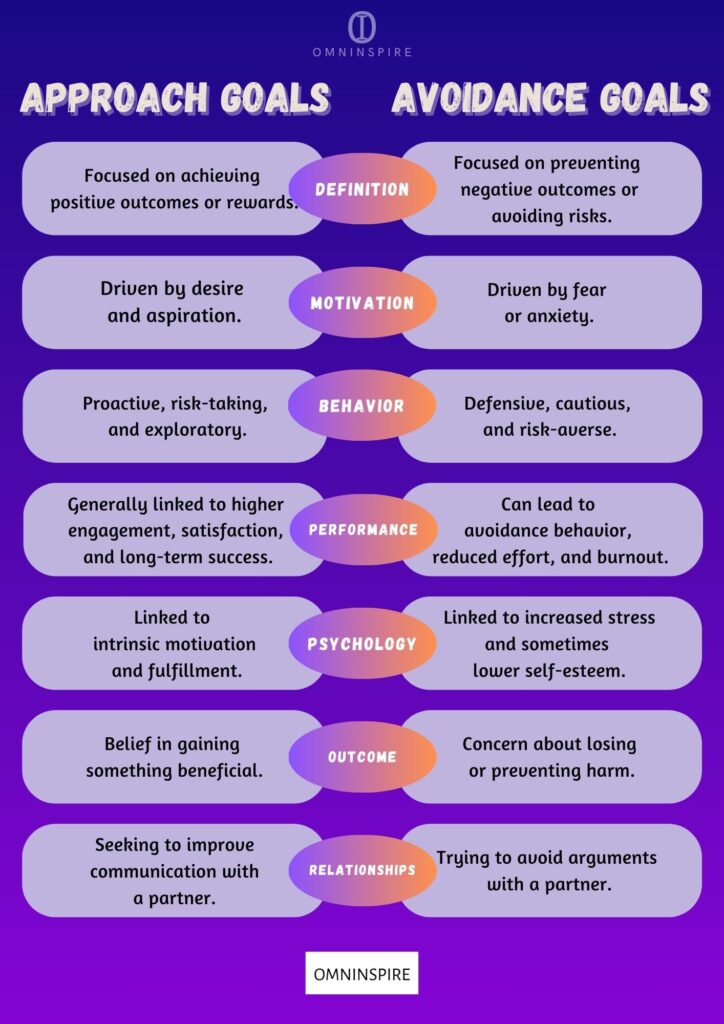Setting goals is a fundamental part of personal and professional growth. However, not all goals are the same. Psychologists have identified two primary types: approach goals and avoidance goals. Each serves a different purpose and significantly impacts motivation, emotional well-being, and overall performance. In this article, we’ll delve deep into the distinctions between approach goals and avoidance goals, explore their psychological impacts, and help you identify how to set goals that lead to long-lasting success.
What Are Approach Goals?
Approach goals are targets aimed at achieving positive outcomes. These goals are driven by a desire to gain something beneficial, such as a skill, experience, or reward. They inspire proactive behavior, encouraging you to strive for growth and self-improvement.
Examples of Approach Goals:
- Striving for a promotion to advance your career.
- Training consistently to complete a marathon.
- Building stronger relationships to foster meaningful connections.
These goals are often associated with feelings of excitement, anticipation, and optimism. For instance, when you set a goal to learn a new language, your focus is on the joy and opportunities it can bring, such as traveling confidently or enhancing career prospects. This positivity fuels intrinsic motivation and keeps you engaged even when challenges arise.
Psychological studies reveal that approach goals are closely tied to personal satisfaction and long-term achievements. They help individuals focus on what they want rather than what they fear, creating an environment of possibilities.
What Are Avoidance Goals?
In contrast, avoidance goals are designed to help you prevent negative outcomes. These goals focus on steering clear of undesirable situations, risks, or consequences. While they serve a protective purpose, they are often accompanied by stress and anxiety.
Examples of Avoidance Goals:
- Avoiding failure in exams by studying late into the night.
- Reducing work-related mistakes to prevent criticism.
- Trying not to argue with loved ones to maintain peace.
Unlike approach goals, which foster excitement, avoidance goals often evoke a sense of fear or relief. For example, aiming to avoid failure might push you to over prepare, but it can also lead to burnout or reduced confidence. The focus on “what could go wrong” can sometimes create more mental strain than motivation.
Key Differences Between Approach Goals and Avoidance Goals
Understanding the differences between these two types of goals is essential for creating a balanced and effective goal-setting strategy. Below is a comprehensive comparison:

This table highlights the contrasting nature of these goals. While approach goals propel you toward opportunities, avoidance goals pull you away from potential dangers. Both serve unique roles depending on the context.
Why Approach Goals Often Lead to Growth
Approach goals inspire a forward-thinking mindset. When you focus on the possibilities of what you can gain, your motivation increases. For instance, aiming to improve your health by eating nutritious food and exercising regularly creates a sense of accomplishment and pride. This positive reinforcement encourages consistency, which leads to sustainable progress.
Additionally, approach goals tap into intrinsic motivation. Studies suggest that people who pursue approach goals are more likely to enjoy the journey, not just the destination. This enjoyment keeps them engaged even during setbacks.
The Hidden Costs of Avoidance Goals
Avoidance goals, while sometimes necessary, come with psychological drawbacks. By focusing on what might go wrong, they can create a fear-based mindset. For instance, trying to avoid criticism at work might make you overly cautious, stifling creativity and risk-taking.
Furthermore, the stress associated with avoidance goals can lead to procrastination. You might delay tasks because they feel overwhelming or because the stakes seem too high. Over time, this approach can reduce confidence and mental well-being, creating a cycle of avoidance.
Striking a Balance: When to Use Both
Both types of goals have their place. While approach goals are generally more effective for growth and engagement, avoidance goals can be valuable in specific situations. For example, avoiding unhealthy habits like smoking or overspending can protect your well-being. The key is not to let avoidance dominate your mindset. Use it to manage risks, but pair it with approach goals to create a more balanced strategy.
How to Set Effective Goals

1. Frame Goals Positively
Instead of focusing on what you want to avoid, concentrate on what you want to achieve. This subtle shift changes your mindset from fear-based to growth-oriented. For example:
- Negative framing: “I don’t want to fail this test.”
- Positive framing: “I want to score above 85% on this test.”
Positive goals inspire optimism and help you visualize success, which fuels motivation. Research shows that a focus on positive outcomes increases engagement and persistence, even when challenges arise. Framing goals positively encourages you to see opportunities rather than obstacles.
2. Be Specific
General goals often lack clarity, which can lead to procrastination or confusion. Instead, make your goals concrete and actionable by breaking them into smaller, measurable tasks. For example:
- Vague goal: “I want to be healthier.”
- Specific goal: “I will exercise for 30 minutes, five days a week.”
Specific goals make it easier to track progress and evaluate success. They also reduce overwhelm by providing clear directions on where to start and what steps to take.
3. Track Your Progress
Regularly monitoring your progress helps maintain motivation and provides a sense of accomplishment. Create measurable milestones or checkpoints to evaluate how far you’ve come. For instance:
- Use tools like journals, spreadsheets, or apps to record daily or weekly achievements.
- Reflect on your progress to identify areas of improvement or celebrate wins.
Tracking progress keeps you accountable and ensures that small, consistent efforts build toward larger outcomes. Psychologists suggest that this habit helps maintain focus and prevents losing sight of long-term goals.
4. Celebrate Successes
Acknowledge and reward yourself for reaching milestones, no matter how small. Celebrating successes reinforces positive behavior and builds confidence. For example:
- After completing a month of regular workouts, treat yourself to new workout gear.
- If you’ve consistently met study goals, take a day off to relax and recharge.
By recognizing your achievements, you create a positive feedback loop. This makes the goal-setting process more enjoyable and sustainable over time.
5. Stay Flexible
Life is unpredictable, and rigid goals can sometimes cause frustration or burnout. Flexibility allows you to adapt goals to changing circumstances while staying aligned with your core values. For example:
- If an injury prevents you from running, shift to a goal of swimming or walking instead.
- When work deadlines intensify, adjust your personal goals to accommodate realistic timelines.
Being flexible doesn’t mean giving up—it means adjusting your approach to ensure progress remains achievable. Studies emphasize that adaptability is crucial for maintaining motivation and reducing stress when setbacks occur.
Approach goals and avoidance goals are both essential tools for achieving success. However, understanding their differences allows you to use them effectively. By prioritizing approach goals and using avoidance goals strategically, you can foster a mindset that drives both happiness and success.
Remember, the key to thriving lies in focusing on opportunities while managing risks responsibly.









